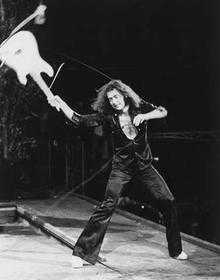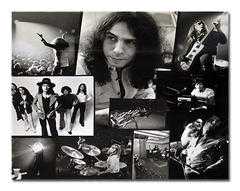ID Card
NAME: RITCHIE BLACKMORE'S RAINBOW
SURNAME: RICHIE BLACKMORE'S RAINBOW
BIRTH YEAR: 1975
RELIGION: HARD ROCK
PARENTS NAME:
RITCHIE BLACKMORE: GUITAR
RONNIE JAMES DIO: VOCALS
MICKY LEE SOULE: KEYBOARDS
CRAIG GRUBER: BASS
GARY DRISCOLL: DRUMS
Found in their possession:
Side A
1. Man On The Silver Mountain
2. Self Portrait
3. ; Black Sheep Of The Family
4. Catch The Rainbow
Side B
1. Snake Charmer
2. The Temple Of The King
3. If You Don't Like Rock 'N' Roll
4. Sixteenth Century Greensleeves
5. Still I'm Sad
Recorded because:
 Left as a legacy songs that not only were classic examples, but they were also the basis for development for the evolution of Hard Rock, whatever direction that took afterwards. Also brought to the fore the great voice with the name Ronnie James Dio.
Left as a legacy songs that not only were classic examples, but they were also the basis for development for the evolution of Hard Rock, whatever direction that took afterwards. Also brought to the fore the great voice with the name Ronnie James Dio.
But let's take things from the beginning:
The year is 1973 and Deep Purple have completed Who Do We Thing We Are and the classic composition (MKII) of the group is under dissolution. After having reached the top with the previous albums comes the expected decline. The conditions call for radical solutions and decisions. We don't know the exact details, however, with the wrong climate between members vocalist Ian Gillan and bassist Roger Glover leave. Their position is taken by David Coverdale and Glenn Hughes, respectively. The change brought the natural result with the release of two very successful records Burn and Strombringer.
But the new air that the two new members brought did not agree with Blackmore. The soul and funky influences was not him and the clouds quickly gathered once again over the new composition (MK III). All that was missing was the reason. And it did not take long for it to come. During the recording of Stormbringer the band refused the proposal by Blackmore to record a cover of Black Sheep Of The Family by Quatermass. So Blackmore started looking for a way to record and release the track regardless of the band (the original idea was to be released as a single). When he finally departed from the band he said that he simply disliked funk and soul music.
 Ronnie James Dio on the other hand had started his music career very early (1957) but did not have the same success as him (Blackmore). The two had met on the tour of Deep Purple in America, that had followed the album Burn. Dio at that time was the singer of Elf the support group to the tour.
Ronnie James Dio on the other hand had started his music career very early (1957) but did not have the same success as him (Blackmore). The two had met on the tour of Deep Purple in America, that had followed the album Burn. Dio at that time was the singer of Elf the support group to the tour.
With the track as the cause, shortly after their first acquaintance, started the cooperation between the two artists, which led to the entire album. Basically the project is a personal project by Blackmore and Dio. The other musicians involved are the other members of Elf. The songs are signed by both. The verse, completely fantastic, is a creation of Dio, while the musical part was more of the guitarist. What is interesting here is that Blackmore isn't quite reminiscent of his old self. The songs here are more robust, build more on rhythm than virtuosic babble and that is obvious from the beginning.
The record opens with Man On The Silver Mountain, a piece with the most recognizable riff in the history of Rock. Interesting, however, is how the song progresses. After the introduction the other instruments begin to fill the room and once the requisite atmosphere has been created comes the voice of Dio to tie everything into a whole. The guitar solo finally comes so naturally as a second voice without adding or removing anything from the piece. Just putting the finishing touch.
 Equally rhythmic and even more powerful Self Portrait and the Sixteenth Century Greensleeves of the other side form the basis per say for the building. In faster beats are the Black Sheep Of The Family, Snake Charmer and If You Don't Like Rock 'N' Roll, and the orchestral Still I'm Sad as opposed to the original by Yardbirds, giving the necessary energy to the momentum of the previous ones.
Equally rhythmic and even more powerful Self Portrait and the Sixteenth Century Greensleeves of the other side form the basis per say for the building. In faster beats are the Black Sheep Of The Family, Snake Charmer and If You Don't Like Rock 'N' Roll, and the orchestral Still I'm Sad as opposed to the original by Yardbirds, giving the necessary energy to the momentum of the previous ones.
And of course there are the legendary ballads Catch The Rainbow and The Temple Of The King. These songs are not classic just because of the melody and atmosphere, but also the performance by Dio, that showed us the other side of his talent.
All of them then placed in the appropriate order create a seamless ensemble as heard from beginning to end. The only thing that justifies a break is the need to turn the vinyl on the other side, because albums like these deserve to be heard by the warm analog format whenever possible.
Other elements:
 The album was recorded at Musicland Studios in Munich, Germany, and released in July 1975 by Polydor. Production was signed by Ritchie Blackmore, Martin Birch, Ronnie Dio. The tracks are all compositions of Ritchie Blackmore and Ronnie James Dio except Black Sheep Of The Family by Steve Hammond and Still I 'm Sad by Yardbirds. In Ritchie Blackmore's Rainbow the piece is orchestral and faster. Later in the Live album On Stage of the band there is the performance of the song with the lyrics.
The album was recorded at Musicland Studios in Munich, Germany, and released in July 1975 by Polydor. Production was signed by Ritchie Blackmore, Martin Birch, Ronnie Dio. The tracks are all compositions of Ritchie Blackmore and Ronnie James Dio except Black Sheep Of The Family by Steve Hammond and Still I 'm Sad by Yardbirds. In Ritchie Blackmore's Rainbow the piece is orchestral and faster. Later in the Live album On Stage of the band there is the performance of the song with the lyrics.
In most versions the back cover contains besides the song titles the lyrics from Sixteenth Century Greensleeves. In the first version the album enclosed photographs of the band, but then to decrease cost the company withdrew them.
The photos in the inside cover are patched by other appearances of the members who played on the record as members of the Elf served only as recording musicians, without participating to the tour. The regular lineup of the group named Rainbow, and adopting the logo, came immediately after the release of the album where instead of Elf, except Dio of course, were enlisted Cozy Powell, Jimmy Bain and Tony Carey on drums, bass and keyboards respectively.
 Rainbow, as a band like we know them with small changes to the members from one album to another, released two more albums Rising and Long Live Rock 'N' Roll. Those records are for many superior to the first project. But then Ritchie Blackmore wanted to go to more commercial tracks, particularly in regards to the themes of the songs. So, keeping only the name Rainbow and changing members he released until 1983 a series of albums, that although experiencing commercial success do not compare musically with the first three. The band's name came from Rainbow Bar and Grill in Hollywood. The real name of Dio is Ronald James Padavona and is of Italian American origin.
Rainbow, as a band like we know them with small changes to the members from one album to another, released two more albums Rising and Long Live Rock 'N' Roll. Those records are for many superior to the first project. But then Ritchie Blackmore wanted to go to more commercial tracks, particularly in regards to the themes of the songs. So, keeping only the name Rainbow and changing members he released until 1983 a series of albums, that although experiencing commercial success do not compare musically with the first three. The band's name came from Rainbow Bar and Grill in Hollywood. The real name of Dio is Ronald James Padavona and is of Italian American origin.
The truth is that Blackmore and Dio are famous for their temperament and ego therefore the fact that they collaborated on three albums and a Live is quite fortunate for fans of this style of music.
The dismantling of the gang continues....
NAME: RITCHIE BLACKMORE'S RAINBOW
SURNAME: RICHIE BLACKMORE'S RAINBOW
BIRTH YEAR: 1975
RELIGION: HARD ROCK
PARENTS NAME:
RITCHIE BLACKMORE: GUITAR
RONNIE JAMES DIO: VOCALS
MICKY LEE SOULE: KEYBOARDS
CRAIG GRUBER: BASS
GARY DRISCOLL: DRUMS
Found in their possession:
Side A
1. Man On The Silver Mountain
2. Self Portrait
3. ; Black Sheep Of The Family
4. Catch The Rainbow
Side B
1. Snake Charmer
2. The Temple Of The King
3. If You Don't Like Rock 'N' Roll
4. Sixteenth Century Greensleeves
5. Still I'm Sad
Recorded because:
 Left as a legacy songs that not only were classic examples, but they were also the basis for development for the evolution of Hard Rock, whatever direction that took afterwards. Also brought to the fore the great voice with the name Ronnie James Dio.
Left as a legacy songs that not only were classic examples, but they were also the basis for development for the evolution of Hard Rock, whatever direction that took afterwards. Also brought to the fore the great voice with the name Ronnie James Dio. But let's take things from the beginning:
The year is 1973 and Deep Purple have completed Who Do We Thing We Are and the classic composition (MKII) of the group is under dissolution. After having reached the top with the previous albums comes the expected decline. The conditions call for radical solutions and decisions. We don't know the exact details, however, with the wrong climate between members vocalist Ian Gillan and bassist Roger Glover leave. Their position is taken by David Coverdale and Glenn Hughes, respectively. The change brought the natural result with the release of two very successful records Burn and Strombringer.
But the new air that the two new members brought did not agree with Blackmore. The soul and funky influences was not him and the clouds quickly gathered once again over the new composition (MK III). All that was missing was the reason. And it did not take long for it to come. During the recording of Stormbringer the band refused the proposal by Blackmore to record a cover of Black Sheep Of The Family by Quatermass. So Blackmore started looking for a way to record and release the track regardless of the band (the original idea was to be released as a single). When he finally departed from the band he said that he simply disliked funk and soul music.
 Ronnie James Dio on the other hand had started his music career very early (1957) but did not have the same success as him (Blackmore). The two had met on the tour of Deep Purple in America, that had followed the album Burn. Dio at that time was the singer of Elf the support group to the tour.
Ronnie James Dio on the other hand had started his music career very early (1957) but did not have the same success as him (Blackmore). The two had met on the tour of Deep Purple in America, that had followed the album Burn. Dio at that time was the singer of Elf the support group to the tour. With the track as the cause, shortly after their first acquaintance, started the cooperation between the two artists, which led to the entire album. Basically the project is a personal project by Blackmore and Dio. The other musicians involved are the other members of Elf. The songs are signed by both. The verse, completely fantastic, is a creation of Dio, while the musical part was more of the guitarist. What is interesting here is that Blackmore isn't quite reminiscent of his old self. The songs here are more robust, build more on rhythm than virtuosic babble and that is obvious from the beginning.
The record opens with Man On The Silver Mountain, a piece with the most recognizable riff in the history of Rock. Interesting, however, is how the song progresses. After the introduction the other instruments begin to fill the room and once the requisite atmosphere has been created comes the voice of Dio to tie everything into a whole. The guitar solo finally comes so naturally as a second voice without adding or removing anything from the piece. Just putting the finishing touch.
 Equally rhythmic and even more powerful Self Portrait and the Sixteenth Century Greensleeves of the other side form the basis per say for the building. In faster beats are the Black Sheep Of The Family, Snake Charmer and If You Don't Like Rock 'N' Roll, and the orchestral Still I'm Sad as opposed to the original by Yardbirds, giving the necessary energy to the momentum of the previous ones.
Equally rhythmic and even more powerful Self Portrait and the Sixteenth Century Greensleeves of the other side form the basis per say for the building. In faster beats are the Black Sheep Of The Family, Snake Charmer and If You Don't Like Rock 'N' Roll, and the orchestral Still I'm Sad as opposed to the original by Yardbirds, giving the necessary energy to the momentum of the previous ones. And of course there are the legendary ballads Catch The Rainbow and The Temple Of The King. These songs are not classic just because of the melody and atmosphere, but also the performance by Dio, that showed us the other side of his talent.
All of them then placed in the appropriate order create a seamless ensemble as heard from beginning to end. The only thing that justifies a break is the need to turn the vinyl on the other side, because albums like these deserve to be heard by the warm analog format whenever possible.
Other elements:
 The album was recorded at Musicland Studios in Munich, Germany, and released in July 1975 by Polydor. Production was signed by Ritchie Blackmore, Martin Birch, Ronnie Dio. The tracks are all compositions of Ritchie Blackmore and Ronnie James Dio except Black Sheep Of The Family by Steve Hammond and Still I 'm Sad by Yardbirds. In Ritchie Blackmore's Rainbow the piece is orchestral and faster. Later in the Live album On Stage of the band there is the performance of the song with the lyrics.
The album was recorded at Musicland Studios in Munich, Germany, and released in July 1975 by Polydor. Production was signed by Ritchie Blackmore, Martin Birch, Ronnie Dio. The tracks are all compositions of Ritchie Blackmore and Ronnie James Dio except Black Sheep Of The Family by Steve Hammond and Still I 'm Sad by Yardbirds. In Ritchie Blackmore's Rainbow the piece is orchestral and faster. Later in the Live album On Stage of the band there is the performance of the song with the lyrics. In most versions the back cover contains besides the song titles the lyrics from Sixteenth Century Greensleeves. In the first version the album enclosed photographs of the band, but then to decrease cost the company withdrew them.
The photos in the inside cover are patched by other appearances of the members who played on the record as members of the Elf served only as recording musicians, without participating to the tour. The regular lineup of the group named Rainbow, and adopting the logo, came immediately after the release of the album where instead of Elf, except Dio of course, were enlisted Cozy Powell, Jimmy Bain and Tony Carey on drums, bass and keyboards respectively.
 Rainbow, as a band like we know them with small changes to the members from one album to another, released two more albums Rising and Long Live Rock 'N' Roll. Those records are for many superior to the first project. But then Ritchie Blackmore wanted to go to more commercial tracks, particularly in regards to the themes of the songs. So, keeping only the name Rainbow and changing members he released until 1983 a series of albums, that although experiencing commercial success do not compare musically with the first three. The band's name came from Rainbow Bar and Grill in Hollywood. The real name of Dio is Ronald James Padavona and is of Italian American origin.
Rainbow, as a band like we know them with small changes to the members from one album to another, released two more albums Rising and Long Live Rock 'N' Roll. Those records are for many superior to the first project. But then Ritchie Blackmore wanted to go to more commercial tracks, particularly in regards to the themes of the songs. So, keeping only the name Rainbow and changing members he released until 1983 a series of albums, that although experiencing commercial success do not compare musically with the first three. The band's name came from Rainbow Bar and Grill in Hollywood. The real name of Dio is Ronald James Padavona and is of Italian American origin. The truth is that Blackmore and Dio are famous for their temperament and ego therefore the fact that they collaborated on three albums and a Live is quite fortunate for fans of this style of music.
The dismantling of the gang continues....
Relevant article

